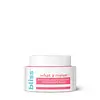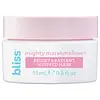What's inside
What's inside
 Key Ingredients
Key Ingredients

 Benefits
Benefits

 Concerns
Concerns

 Ingredients Side-by-side
Ingredients Side-by-side

Water
Skin ConditioningGlycerin
HumectantPropanediol
SolventCitrullus Lanatus Fruit Extract
Skin ConditioningXylitylglucoside
HumectantAnhydroxylitol
HumectantTocopherol
AntioxidantCopper Gluconate
Skin ConditioningSodium Hyaluronate
HumectantSqualane
EmollientCucumis Sativus Fruit Extract
EmollientAvena Sativa Kernel Extract
AbrasiveOryza Sativa Bran Extract
Skin ConditioningGlycine Soja Oil
EmollientLecithin
EmollientAloe Barbadensis Leaf Juice
Skin ConditioningCitrulline
Skin ConditioningMagnesium Aspartate
Skin ConditioningSclerotium Gum
Emulsion StabilisingXanthan Gum
EmulsifyingZinc Gluconate
Skin ConditioningHydroxyethyl Acrylate/Sodium Acryloyldimethyl Taurate Copolymer
Emulsion StabilisingDisodium Lauriminodipropionate Tocopheryl Phosphates
CleansingXylitol
HumectantSynthetic Fluorphlogopite
Polysorbate 60
EmulsifyingSorbitan Isostearate
EmulsifyingSilica
AbrasiveTin Oxide
AbrasivePullulan
Isohexadecane
EmollientTetrasodium Glutamate Diacetate
Phenoxyethanol
PreservativeEthylhexylglycerin
Skin ConditioningPotassium Sorbate
PreservativeBenzoic Acid
MaskingSodium Benzoate
MaskingDehydroacetic Acid
PreservativeCitric Acid
BufferingParfum
MaskingCI 77891
Cosmetic ColorantCI 17200
Cosmetic ColorantWater, Glycerin, Propanediol, Citrullus Lanatus Fruit Extract, Xylitylglucoside, Anhydroxylitol, Tocopherol, Copper Gluconate, Sodium Hyaluronate, Squalane, Cucumis Sativus Fruit Extract, Avena Sativa Kernel Extract, Oryza Sativa Bran Extract, Glycine Soja Oil, Lecithin, Aloe Barbadensis Leaf Juice, Citrulline, Magnesium Aspartate, Sclerotium Gum, Xanthan Gum, Zinc Gluconate, Hydroxyethyl Acrylate/Sodium Acryloyldimethyl Taurate Copolymer, Disodium Lauriminodipropionate Tocopheryl Phosphates, Xylitol, Synthetic Fluorphlogopite, Polysorbate 60, Sorbitan Isostearate, Silica, Tin Oxide, Pullulan, Isohexadecane, Tetrasodium Glutamate Diacetate, Phenoxyethanol, Ethylhexylglycerin, Potassium Sorbate, Benzoic Acid, Sodium Benzoate, Dehydroacetic Acid, Citric Acid, Parfum, CI 77891, CI 17200
Water
Skin ConditioningGlycerin
HumectantButylene Glycol
HumectantCaprylic/Capric Triglyceride
MaskingHydroxyethyl Urea
HumectantPEG/PPG-17/6 Copolymer
SolventOlea Europaea Fruit Oil
MaskingCetearyl Alcohol
EmollientCetyl Ethylhexanoate
EmollientAscorbic Acid
AntioxidantTocopheryl Acetate
AntioxidantAscorbyl Glucoside
AntioxidantSodium Ascorbyl Phosphate
AntioxidantOlea Europaea Leaf Extract
PerfumingPhyllanthus Emblica Fruit Extract
HumectantOpuntia Coccinellifera Fruit Extract
Skin ConditioningAlthaea Officinalis Root Extract
Skin ConditioningHydrolyzed Acacia Macrostachya Seed Extract
Skin ConditioningCitrus Aurantium Dulcis Peel Oil
MaskingCitrus Aurantium Bergamia Fruit Oil
MaskingCitrus Aurantifolia Oil
CleansingCitrus Limon Peel Oil
MaskingEucalyptus Globulus Leaf Oil
PerfumingPinus Sylvestris Leaf Oil
MaskingZinc PCA
HumectantAmmonium Acryloyldimethyltaurate/Beheneth-25 Methacrylate Crosspolymer
Emulsion StabilisingPolysorbate 20
EmulsifyingPolysorbate 60
EmulsifyingStearic Acid
CleansingGlyceryl Stearate
EmollientSorbitan Stearate
EmulsifyingSorbitan Isostearate
EmulsifyingPEG-100 Stearate
Polyacrylate-13
Dimethicone
EmollientCaprylyl Glycol
EmollientSodium Acrylates Crosspolymer-2
AbsorbentPolyisobutene
Maltodextrin
AbsorbentDisodium EDTA
Phenoxyethanol
PreservativeEthylhexylglycerin
Skin ConditioningChlorphenesin
AntimicrobialTetrasodium Pyrophosphate
BufferingLimonene
PerfumingCI 77891
Cosmetic ColorantCI 17200
Cosmetic ColorantWater, Glycerin, Butylene Glycol, Caprylic/Capric Triglyceride, Hydroxyethyl Urea, PEG/PPG-17/6 Copolymer, Olea Europaea Fruit Oil, Cetearyl Alcohol, Cetyl Ethylhexanoate, Ascorbic Acid, Tocopheryl Acetate, Ascorbyl Glucoside, Sodium Ascorbyl Phosphate, Olea Europaea Leaf Extract, Phyllanthus Emblica Fruit Extract, Opuntia Coccinellifera Fruit Extract, Althaea Officinalis Root Extract, Hydrolyzed Acacia Macrostachya Seed Extract, Citrus Aurantium Dulcis Peel Oil, Citrus Aurantium Bergamia Fruit Oil, Citrus Aurantifolia Oil, Citrus Limon Peel Oil, Eucalyptus Globulus Leaf Oil, Pinus Sylvestris Leaf Oil, Zinc PCA, Ammonium Acryloyldimethyltaurate/Beheneth-25 Methacrylate Crosspolymer, Polysorbate 20, Polysorbate 60, Stearic Acid, Glyceryl Stearate, Sorbitan Stearate, Sorbitan Isostearate, PEG-100 Stearate, Polyacrylate-13, Dimethicone, Caprylyl Glycol, Sodium Acrylates Crosspolymer-2, Polyisobutene, Maltodextrin, Disodium EDTA, Phenoxyethanol, Ethylhexylglycerin, Chlorphenesin, Tetrasodium Pyrophosphate, Limonene, CI 77891, CI 17200
Ingredients Explained
These ingredients are found in both products.
Ingredients higher up in an ingredient list are typically present in a larger amount.
Ci 17200 is a synthetic reddish-purple dye.
Ci 77891 is a white pigment from Titanium dioxide. It is naturally found in minerals such as rutile and ilmenite.
It's main function is to add a white color to cosmetics. It can also be mixed with other colors to create different shades.
Ci 77891 is commonly found in sunscreens due to its ability to block UV rays.
Learn more about CI 77891Ethylhexylglycerin (we can't pronounce this either) is commonly used as a preservative and skin softener. It is derived from glyceryl.
You might see Ethylhexylglycerin often paired with other preservatives such as phenoxyethanol. Ethylhexylglycerin has been found to increase the effectiveness of these other preservatives.
Glycerin is already naturally found in your skin. It helps moisturize and protect your skin.
A study from 2016 found glycerin to be more effective as a humectant than AHAs and hyaluronic acid.
As a humectant, it helps the skin stay hydrated by pulling moisture to your skin. The low molecular weight of glycerin allows it to pull moisture into the deeper layers of your skin.
Hydrated skin improves your skin barrier; Your skin barrier helps protect against irritants and bacteria.
Glycerin has also been found to have antimicrobial and antiviral properties. Due to these properties, glycerin is often used in wound and burn treatments.
In cosmetics, glycerin is usually derived from plants such as soybean or palm. However, it can also be sourced from animals, such as tallow or animal fat.
This ingredient is organic, colorless, odorless, and non-toxic.
Glycerin is the name for this ingredient in American English. British English uses Glycerol/Glycerine.
Learn more about GlycerinPhenoxyethanol is a preservative that has germicide, antimicrobial, and aromatic properties. Studies show that phenoxyethanol can prevent microbial growth. By itself, it has a scent that is similar to that of a rose.
It's often used in formulations along with Caprylyl Glycol to preserve the shelf life of products.
Polysorbate 60 is used to help stabilize products. It is a surfactant and emulsifier. These properties help keep ingredients together in a product. Surfactants help reduce surface tension between ingredients with different states, such as liquids and solids. Emulsifiers help prevent oils and waters from separating.
Polysorbate 60 is sorbitol-based and created from the ethoxylation of sorbitan. Ethoxylation is a chemical reaction used to add ethylene oxide. Sorbitan is a the dehydrated version of sorbitol, a sugar found in fruits.
In this case, the 60 comes from reacting 60 units of ethylene oxide with sorbitan.
Polysorbates are commonly used in medicine and foods.
Learn more about Polysorbate 60Sorbitan Isostearate is an emulsifer and cleaning agent. It is created from isostearic acid and sorbitol.
As an emulsifier, Sorbitan Isostearate prevents oils and water from separating.
Due to its isostearic acid base, it may not be safe for Malassezia or fungal acne.
Learn more about Sorbitan IsostearateWater. It's the most common cosmetic ingredient of all. You'll usually see it at the top of ingredient lists, meaning that it makes up the largest part of the product.
So why is it so popular? Water most often acts as a solvent - this means that it helps dissolve other ingredients into the formulation.
You'll also recognize water as that liquid we all need to stay alive. If you see this, drink a glass of water. Stay hydrated!
Learn more about Water